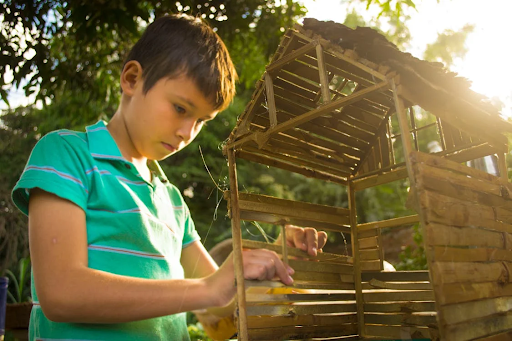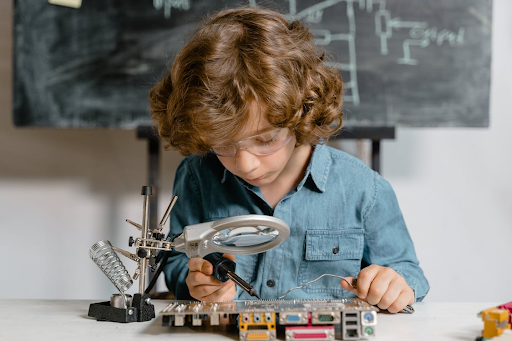
Nowadays, hands-on learning in education is very much established, and of course, its impact on the development of children’s brains is profound. This method, which is also called experiential learning, gives children an opportunity to interact with materials and experiments that bring the subject matter alive.
Hands-on learning is said to be a different approach from the traditional ways where memorization is important, while this type of learning is based on “learning by doing.” It makes the learning experience more dynamic and meaningful.
Hands-on learning can be more effective when utilized in early childhood education, where fresh, young, and curious minds want to experiment and figure out things around them. Whether it is through a science experiment, a project-based activity, or even a field study, this method can boost kids’ curiosity and propel them to ask questions, solve problems, and become more analytical. Hands-on experiences definitely solidify whatever concepts were learned from theoretical knowledge, and thus, it makes it easier for a child to retain information and apply it.
In addition, hands-on learning extends beyond academic subjects to vocational training and apprenticeships, where valuable life skills are gained, both for personal development and in future professional applications. Integrating real-world applications into learning equips children to overcome challenges as they arm their little minds with the appropriate tools to lead their way into an increasingly dynamic world.
What is Hands-On Learning?
This method is mostly known as experiential or practical learning. Here, the learner is directly engaged with an activity, task, or experiment. Here, the students are at the centre of the entire learning process and will be able to manipulate the materials, explore real-life scenarios, and be actively involved in learning. Conventional teaching methods revolve around the passive reception of information. In experiential learning, however, a student must get in touch with their environment as they ask questions and solve problems in real time.
Practical experience is very relevant in education. It bridges the gap between abstract theory and application by engaging students in tangible tasks through hands-on learning. The learning process is more relevant and easier to understand, especially for young children who learn by playing and exploring. For example, in a science class, conducting experiments allows students to see theories in action, solidifying their understanding of complex concepts.
Hands-on learning also develops essential life skills that include critical thinking, teamwork, and innovativeness. During group projects, students develop their communication skills, distribute tasks, and innovate to devise solutions for setbacks that may crop up. Such activities not only mean an increase in academic knowledge but also prepare the students for scenarios that most working professionals face, mostly teamwork and problem-solving.
6 Key Benefits of Hands-On Learning
1. Enhanced Retention of Information
Hands-on activities greatly improve memory retention because one is actually engaging with the materials they are learning about. A child who is physically working with objects, conducting experiments, or doing any interactive learning establishes powerful cognitive associations that help them remember what they learn. This kind of sensory involvement with knowledge helps it to be encoded much better than rote learning.
2. Development of Critical Thinking and Problem-Solving Skills
With the involvement of students as active participants in their learning, hands-on learning inculcates important critical thinking and problem-solving abilities. With practical, real-life problems or activities, children are prompted to think about the situation, make decisions, and construct solutions, thereby not only developing tenacity but also the capacity to logically and creatively think. Hands-on learning environments thus become a fertile ground for developing these crucial skills.
3. Increased Engagement and Motivation
Hands-on learning also plays a vital role in keeping children engaged and motivated. Unlike passive learning methods, practical activities capture children’s interest and curiosity. That’s why the thrill of discovering new ideas through direct interaction will ensure a lifelong passion for learning. Seeing some level of tangible result of their efforts makes the student much more likely to remain interested in the educational process.
4. Fosters Creativity and Innovation
Hands-on activities stimulate creativity because students are encouraged to think out of the box and consider several ways or alternatives for a solution. The freedom children get in engaging in model building, science experiments, or art helps them develop a mindset of creativity and originality to such an extent that they become good at coming up with new ideas and approaches.
5. Builds Teamwork and Collaboration Skills
Teamwork and collaboration skills are naturally evolved within a hands-on learning environment. For instance, at group projects or experiments, teamwork among students develops more effective ways of communicating, sharing responsibility, and utilizing each others’ strengths. The diversity and efforts of people in that group provide the building blocks of community and teach valuable interpersonal skills necessary for success in school and later on in their professional lives.
6. Real-World Application of Knowledge
Connecting theoretical knowledge with real-world applications is a cornerstone of hands-on learning. For example, in math classes, students might use measurements to build structures, allowing them to see how abstract concepts are applied in tangible ways. This real-world relevance not only makes learning more engaging but also helps students understand the practical importance of the subjects they study, thereby solidifying their grasp of the material.
Examples of Hands-On Learning Methods
Science Labs and Experiments

Hands-on learning in science is represented frequently by labs and experiments where the students can witness scientific concepts in action. The process of mixing chemicals or observing reactions, even the creation of models before their eyes, shows them how simple theories come alive. This hands-on experience makes them not only more knowledgeable but also more interested and enthusiastic about the subject matter. Lab work helps to train students in formulating hypotheses, conducting experiments, and analyzing results, which are all a part of the scientific process.
Project-Based Learning
Another very effective hands-on teaching methodology is Project-Based Learning (PBL). Through PBL, students are engaged in activities in the form of projects requiring applications of various subjects toward solving real-world problems. A classic example is designing a sustainable garden, integrating lessons from biology and chemistry as well as environmental science.
In PBL, students learn the subject knowledge in an integrated and holistic way as they research, plan, execute, and present a project. A very concrete application, it encourages in-depth learning and retention of material because students can immediately see the result of their effort.
Field Trips and Educational Outings
Field trips and educational excursions are among the most practical learning conditions that permit extracting students from the four walls of the classroom to experience first-hand the existence of real-life environments while interfacing with subject matter. Examples include visits to museums, nature reserves, or historical sites that make learning more accessible and relevant. It opens the eyes of the students to practical applications of what they have been taught in the classroom, thereby enriching their understanding and retention levels. Real-life exposure also makes them curious about other fields of study.
Vocational Training and Apprenticeships
Vocational training and apprenticeships are the most important types of practical learning, especially in vocational education. These programs arm the trainees with a wide range of practical skills directly applicable to careers. By having a professional mentor, learners can experience on-the-job exposure, which would not be possible in the classroom.
Apprenticeships allow trainees to use their theoretical knowledge in real-life situations; this heightens the level of proficiency of learners and their confidence in a specific field. This kind of learning provides students with a fast and easy transition into the job market and fosters skills that can be made available for them to adapt to changes that would later be introduced in the industry.
Challenges in Hands-On Learning
Resource and Time Constraints
Resource and time constraints are common challenges in implementing hands-on learning. Materials for experiments, project supplies, and field trip costs can strain school budgets while preparing and facilitating hands-on activities demands significant time from teachers. One solution is to seek community partnerships or grants that provide funding and resources. Additionally, integrating hands-on activities into existing curricula can maximize instructional time without overburdening educators. Utilizing simple, low-cost materials can also be effective, ensuring all students have the opportunity to participate.
Assessing Hands-On Learning Outcomes
Assessing hands-on learning outcomes can be complex, as traditional tests may not capture the full scope of student understanding and skills. Alternative evaluation methods like portfolios, project presentations, and peer assessments can provide a more comprehensive view of student progress. Balancing these practical evaluations with conventional assessments ensures that both theoretical knowledge and applied skills are measured. This dual approach allows educators to recognize diverse student strengths and fosters a more well-rounded educational experience.
Conclusion
Hands-on learning offers many benefits that will make children’s education much more rewarding. It makes learners be more active at exploring and engaging with different materials as well as to real life situations making them remember things better, develop their sense of critical thinking and solve problems more effectively. The method also creates room for creativity, teamwork as well as offering practical knowledge with direct applicability to real life situations showing students what they learn in the classroom in action.
Embracing hands-on learning methods can transform the way children perceive education, making it more engaging and enjoyable. Integrating activities like science labs, project-based learning, field trips, and vocational training into the curriculum helps bridge the gap between theoretical concepts and practical use. These experiences not only make learning more memorable but also equip students with essential life skills.
For educators and parents, supporting hands-on learning involves creating opportunities for children to explore, experiment, and collaborate. Simple adjustments in teaching approaches, seeking community partnerships, or utilizing low-cost materials can make a significant difference. By encouraging a hands-on approach, we can nurture a generation of curious, motivated, and well-rounded individuals ready to tackle future challenges.
FAQs
1. How can teachers effectively implement hands-on learning in the classroom?
Teachers can effectively implement hands-on learning by integrating project-based activities, lab experiments, and interactive tasks into their lessons. Utilizing community resources and low-cost materials can also enhance this approach.
2. What challenges might educators face with hands-on learning, and how can they overcome them?
Educators may face challenges like resource constraints and time limitations. Overcoming these can involve seeking community partnerships, grants, and integrating hands-on activities into existing curricula.
3. Is hands-on learning suitable for all subjects?
Hands-on learning is suitable for all subjects, as it enhances understanding through practical application.
4. How does hands-on learning contribute to student engagement and motivation?
It boosts student engagement by making learning interactive and tangible, sparking curiosity and motivation.
5. Can hands-on learning be integrated with digital tools and technology?
Digital tools can complement hands-on learning by offering simulations, virtual labs, and interactive platforms.
6. How can parents support hands-on learning at home?
Parents can support hands-on learning at home by providing opportunities for exploration and experimentation, such as DIY projects or educational games.

